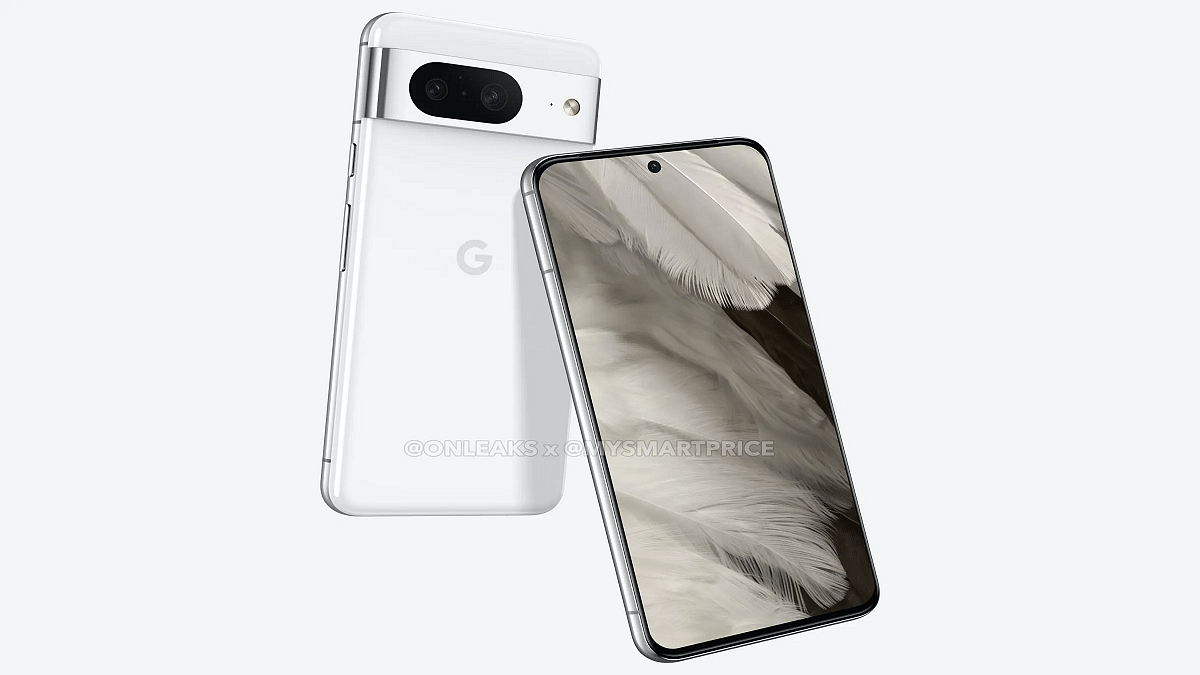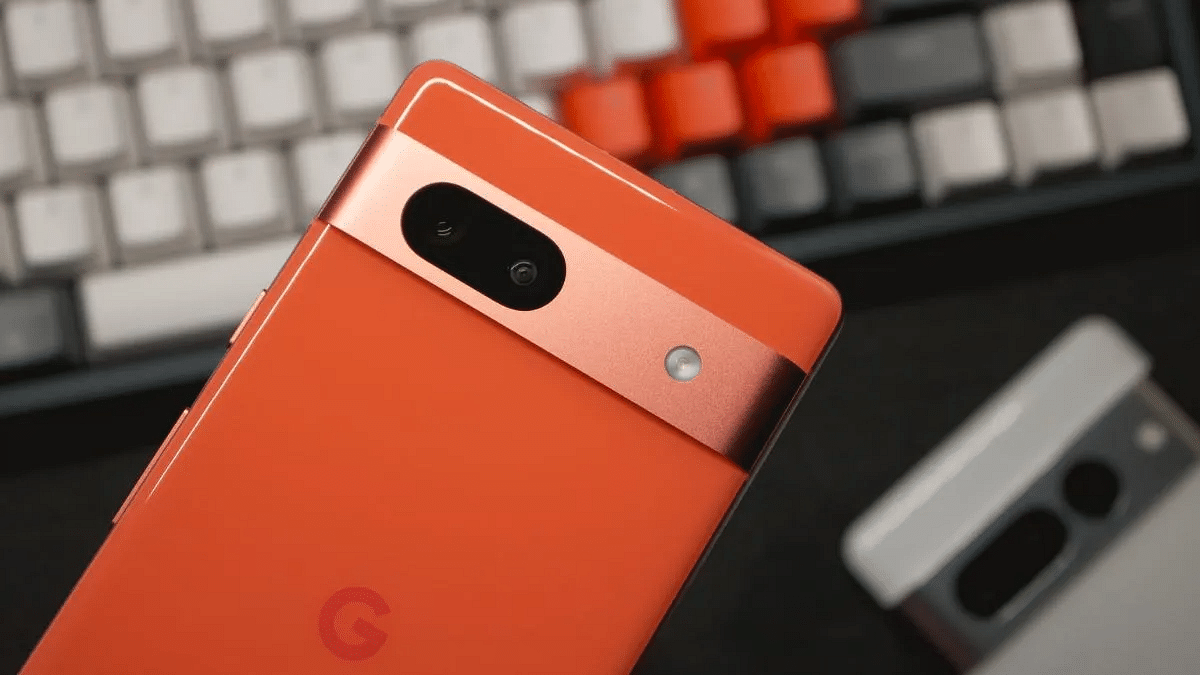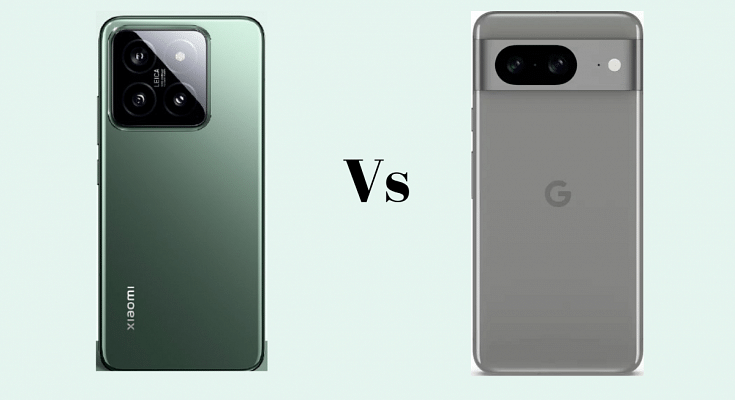Xiaomi 14 and Google Pixel 8 are two Android smartphones that offer different features and specifications. In this comparison article, we’ll take a closer look at these two devices, examining their body, display, platform, camera, battery, and other essential aspects.
Also Read: Xiaomi Book Pro 14 (2022) and Lenovo IdeaPad 5 15” (Intel): Which Laptop Offers the Best Value?
Xiaomi 14 Vs Google Pixel 8: Body And Build
| Specification | Xiaomi 14 | Google Pixel 8 |
|---|---|---|
| Dimensions (mm) | 152.8 x 71.5 x 8.2 or 8.3 mm | 150.5 x 70.8 x 8.9 mm |
| Weight (g) | 188 g or 193 g | 187 g |
| Build | Glass front, glass/silicone back, aluminum frame | Glass front and back, aluminum frame |
| IP Rating | IP68 (dust/water resistant) | IP68 (dust/water resistant) |

Xiaomi 14 comes with a sleek design with dimensions of 152.8 x 71.5 x 8.2 mm or 8.3 mm and a weight of 188 g or 193 g. It features a glass front and back with an aluminium frame, providing a premium and sturdy build. It is also IP68 dust and water-resistant, allowing it to withstand submersion up to 1.5 meters for 30 minutes. Users can choose between a glass back or a silicone polymer back.
In contrast, the Google Pixel 8 has a slightly smaller and lighter build, measuring 150.5 x 70.8 x 8.9 mm and weighing 187 g. It features a glass front and back with an aluminium frame and IP68-rated for dust and water resistance.
Xiaomi 14 Vs Google Pixel 8: Display
| Specification | Xiaomi 14 | Google Pixel 8 |
|---|---|---|
| Type | LTPO OLED, 68B colors, 120Hz, Dolby Vision, HDR10+ | OLED, 120Hz, HDR10+ |
| Size | 6.36 inches | 6.2 inches |
| Resolution | 1200 x 2670 pixels | 1080 x 2400 pixels |
| Peak Brightness | 3000 nits | 2000 nits (peak) |

Xiaomi 14 comes with a 6.36-inch LTPO OLED display with impressive features like 120Hz refresh rate, Dolby Vision, HDR10+, and a peak brightness of 3000 nits. This display ensures vibrant colours and smooth visuals. Google Pixel 8, on the other hand, offers a 6.2-inch OLED display with a 120Hz refresh rate and HDR10+ support. While it may not match Xiaomi 14’s peak brightness, it still provides an excellent viewing experience.
Also Read: Xiaomi Pad 6 Vs OnePlus Pad 5G: Best Premium Android Tablet In India In 2023
Xiaomi 14 Vs Google Pixel 8: Platform
| Specification | Xiaomi 14 | Google Pixel 8 |
|---|---|---|
| OS | Android 14, HyperOS | Android 14 |
| Chipset | Qualcomm Snapdragon 8 Gen 3 | Google Tensor G3 |
| CPU | Octa-core | Nona-core |
| GPU | Adreno 750 | Immortalis-G715s MC10 |

Xiaomi 14 runs on Android 14 with the HyperOS overlay. It is powered by the Qualcomm Snapdragon 8 Gen 3 chipset, featuring an octa-core CPU with Cortex-X4, Cortex-A720, and Cortex-A520 cores, along with an Adreno 750 GPU. On the other hand, the Google Pixel 8 runs on Android 14 with Google’s custom Tensor G3 chipset, equipped with a nona-core CPU and the Immortalis-G715s MC10 GPU.
Xiaomi 14 Vs Google Pixel 8: Camera
| Specification | Xiaomi 14 | Google Pixel 8 |
|---|---|---|
| Main Camera | Triple: 50 MP wide, 50 MP telephoto, 50 MP ultrawide | Dual: 50 MP wide, 12 MP ultrawide |
| Camera Features | Leica lenses, Dual-LED flash, HDR, panorama | Dual-LED flash, Pixel Shift, Ultra-HDR, panorama, Best Take |
| Video Capabilities | 8K@24fps, 4K@24/30/60fps, 1080p@30/60/120/240/960fps | 4K@24/30/60fps, 1080p@30/60/120/240fps; gyro-EIS, OIS, 10-bit HDR |

Xiaomi 14 offers a triple-camera setup with three 50 MP lenses for wide, telephoto, and ultrawide shots. The camera setup includes features like Leica lenses, dual-LED dual-tone flash, and impressive video recording capabilities, including 8K at 24fps and 4K at up to 60fps.
Google Pixel 8, on the other hand, features a dual-camera setup with a 50 MP wide lens and a 12 MP ultrawide lens. While the Pixel 8’s camera system may seem simpler, it excels in computational photography, providing good image quality, and supports 4K video recording.
Also Read: Xiaomi Pad 6 Max Key Specifications Teased Ahead Of August 14 launch: Details
Xiaomi 14 Vs Google Pixel 8: Battery And Charging
| Specification | Xiaomi 14 | Google Pixel 8 |
|---|---|---|
| Battery Type | Li-Po 4610 mAh, non-removable | Li-Ion 4575 mAh, non-removable |
| Fast Charging | 90W wired, 50W wireless, 10W reverse wireless | 27W wired, 18W wireless, reverse wireless |
| Charging Speed | 100% in 31 min (wired), 100% in 46 min (wireless) | 50% in 30 min (wired) |

Xiaomi 14 is equipped with a 4610 mAh non-removable battery and supports fast charging with a 90W wired charger, claiming a full charge in just 31 minutes. It also supports 50W wireless charging and 10W reverse wireless charging.
Google Pixel 8 has a 4575 mAh non-removable battery and supports 27W wired charging, claiming 50% charge in 30 minutes, as well as 18W wireless charging and reverse wireless charging. Both phones offer fast charging options, with Xiaomi 14 taking the lead in wired charging speed.
Xiaomi 14 Vs Google Pixel 8: Final Verdict

Xiaomi 14 offers a larger, more versatile camera setup, a stunning display, and faster-wired charging, making it an attractive option for multimedia enthusiasts. Google Pixel 8, with its computational photography prowess, stock Android experience, and solid build quality, is a good choice for those who prioritize photography and simplicity. The decision between these two phones will ultimately depend on your priorities in a smartphone.
